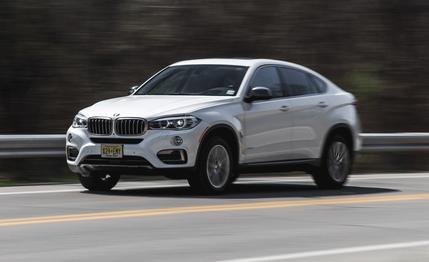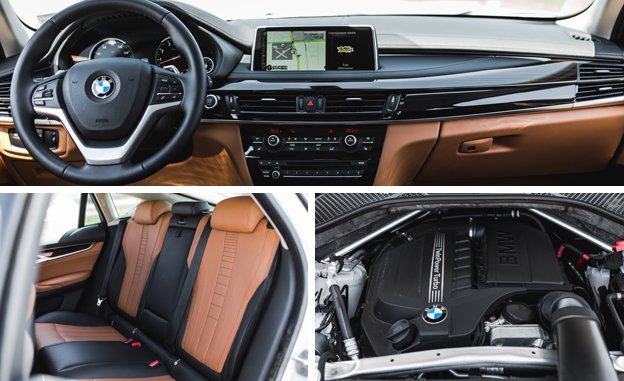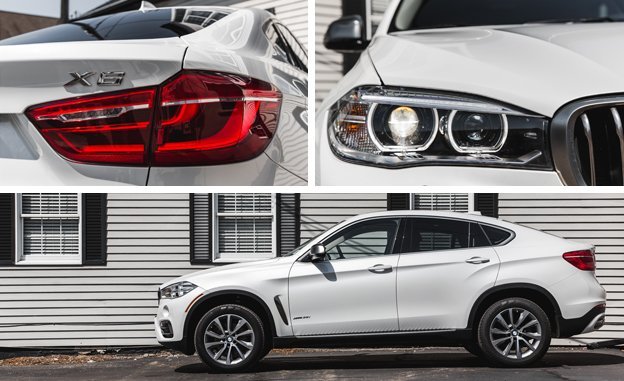
 Instrumented Test
Instrumented Test
Okay, we’ve been banging on about the strangeness of the BMW X6—a fastbacked, hatch-havin’ four-door “coupe” version of the X5 “Sports Activity Vehicle”—since it arrived as a 2008 model. Seven years of Backfires comments comparing it to everything from the Pontiac Aztek to the 1980s AMC Eagle Spirit suggest readers agree with us that it’s one odd automotive platypus.
Yet more than 250,000 buyers worldwide heard the X6’s siren call and took one home. Sort of in the same way some people walk right past Golden Labs to adopt Chinese Crested dogs. And in the way that patent-leather work boots are a thing. That’s just how the free-market capitalist economy works. A quarter-million isn’t a huge number in the greater scheme of things, but it represents enough profit that BMW introduced the second-generation X6 for 2015. More than that, it has extended the idea downmarket to the X4 and is even prepping an X2 for 2017.
So all that’s left to do is regard the X6 as part of the new normal. For us, that means taking it to the track for some numbers and then driving it around for subjective evaluation. Hey, it’s at least as good a time as judging whether the new whiskey-and-haggis potato chips are as good as the chicken-and-waffles variety.
Like the third-gen BMW X5 introduced for 2014, the new X6 rides the same 115.5-inch wheelbase as before. The fastback design has been updated with exterior character lines forecast by last year’s X4, but these look better-proportioned when stretched over the longer X6, which has gained 1.8 inches in overall length. The redesigned interior departs more dramatically from the past but not at all from recent BMW practice, with a prominent 10.2-inch screen taking center stage on the dash. It’s coupled to the latest version of iDrive, which has evolved from its initial status as a horrific burden right on through manageable to a genuinely useful system. This example was graced with a $1950 “Cognac Interior Design” package that blended brownish-red accents, black leather, and “Fineline Striped” wood trim into a plush cabin ambience. It was a little more old-school than some of our drivers might prefer, but as with most BMWs, there are many other choices (such as metal rather than wood trim). Remember when the cabin of a BMW was always a black hole with big daylight openings? That’s the old normal.


Reinvention for its own sake is not always fruitful, though. We still aren’t big fans of BMW’s latest thinking on the electronic automatic shift lever, with its side release button and complex array of choices that never seem to come naturally, but at least the X6 comes with paddles to manage manual gear selection.
The rear seat now has a seatbelt for a center occupant where the previous model was strictly a four-seater. BMW correctly calls this 4+1 seating, the center being uncomfortable for anyone but small children, who ought to be in a safety seat anyway. This back seat (the roofline precludes the cramped third row offered in the X5) folds in a 40/20/40 configuration, useful when cargo needs exceed the 26.6 cubic feet of space accessed through the hatch, which is now power-operated.
Not compromised by the styling is the towing capacity of 6000 pounds (48 pounds more than the X5 for unknown reasons), and BMW fan-site message boards suggest that many owners actually use their X6s to pull a boat, camper, ATVs, or a trailer full of racing or collector cars. Maybe some of these folks are like us after all—if you don’t need the enormous capacity of modern pickups or full-size SUVs, the experience of driving an X6 is a far more entertaining way to spend your non-towing road miles. That it will tow, at least, is some justification for choosing an X6 rather than a more conventional vehicle.
The xDrive35i we tested employs the 300-hp straight six with a twin-scroll turbocharger. Also found in the top X4 and in many other Munich offerings, this sweetly responsive six is the base X5/X6 engine and, for the first time, is also offered with rear-wheel drive (sDrive in BMW nomenclature). Testing the all-wheel-drive model makes for a tidy comparison with the X6 xDrive35i we examined back in 2008. The 300 horsepower and 300-lb-ft figures are the same, with mild differences in their delivery (today’s torque comes in a little earlier in the rev band while power peaks later); and the ’08 model used a six-speed automatic instead of today’s eight-cog ’box (the eight-speed was bestowed upon the X6 for 2011). BMW claims it invested heavily in weight reduction on the new platform and lists curb weights that average about 50 pounds less than before; our 2015 test car was 298 pounds lighter than was the ’08 on our scales, but the older car had optional equipment that wasn’t primarily software based, including beefy 20-inch wheels rather than the 19-inchers on this example.
In the sprint to 60 mph, the 2015 X6 did the job in 5.7 seconds, a 0.2-second improvement over the ’08 and 0.3 better than the X5 xDrive35i we tested just over a year ago. The square-backed model is heftier by a couple hundred pounds. The X6’s advantage continued to 100 mph and in the quarter-mile, which this car did in 14.3 seconds at 97 mph (the ’08 X6 and the ’14 X5 ran 14.6 seconds at 95 and 96 mph). Where the eight-speed and the weight reduction really pay off big is in fuel economy. The EPA ratings of 18/27 mpg city/highway represent improvements of 3 and 7 mpg. We saw a real-world 21 mpg in this example, the same as we got in the 2014 X5 and fully 5 mpg better than in our ’08 testing.


In braking, the new car stopped from 70 mph in 168 feet, improving on the X5’s 175-foot stop but not the previous model’s 163. Perhaps that was due to the smaller wheel and tire—skidpad grip ran out at 0.86 g whereas the ’08 managed 0.88. The X6 outcornered the 0.81 g we measured in the latest X5, though—both cars had 19-inch wheels, but this one ran Pirelli tires and the X5 had Goodyears, both all-season run-flat designs.
On the road, this all equates to a heavyweight that can get up on its toes and dance around the ring, but you’d best hope the opposite corner isn’t occupied by a Porsche Cayenne. The BMW’s steering is hefty but responds proportionally to inputs, and although it feels a mite too stiff-necked on-center and gives no sense of road texture, it at least allows precise control for the demanding driver. The handling balance denotes this as a real BMW. It lacks the scalpel-like precision that marks the best Munich machines, but it’s more entertaining than most any SUV short of that Cayenne.
If your neighbor’s Porsche is your target, BMW offers the 445-hp 4.4-liter V-8 in its X6 xDrive50i, which will square more nicely against Porsche’s latest 420-hp Cayenne S. And there’s an X6 M for those who must rest atop the country-club food chain. But now you’re talking some long green, as in a six-figure MSRP.
Even as equipped, with more than $10,000 in options, this X6 fell short of the $75K that Stuttgart commands for an S. (The basic, 300-hp Cayenne starts at $59,295 with standard AWD.) Beyond the interior design package, add-ons included $2500 for the xLine trim (differently styled 19-inch wheels and aluminum running boards), $1300 for multicontour seats, as well as $3250 for packages labeled Cold Weather (heated rear seats and steering wheel plus retractable headlight washers, $550), Driver Assistance (rearview camera and head-up display, $1400), and Premium (passive entry, four-zone automatic climate control, and satellite radio, $1300). Another $750 added side- and top-view cameras for full-surround vision on that big screen—a good thing in a car that can be difficult to see out of using the old, analog eyes-and-mirrors methods. You could go deeper, of course, and the most tempting option is M Sport. The first step into M Sport land brings mostly visual trimmings but then opens the door to the Adaptive M suspension option, which includes the Dynamic Handling package with adjustable air suspension for the rear axle (the latter is available as a stand-alone option without M Sport). It would add more than $5000 to the final tally, but you know going in that swimming with the big platypuses is never cheap.